全文HTML
--> --> -->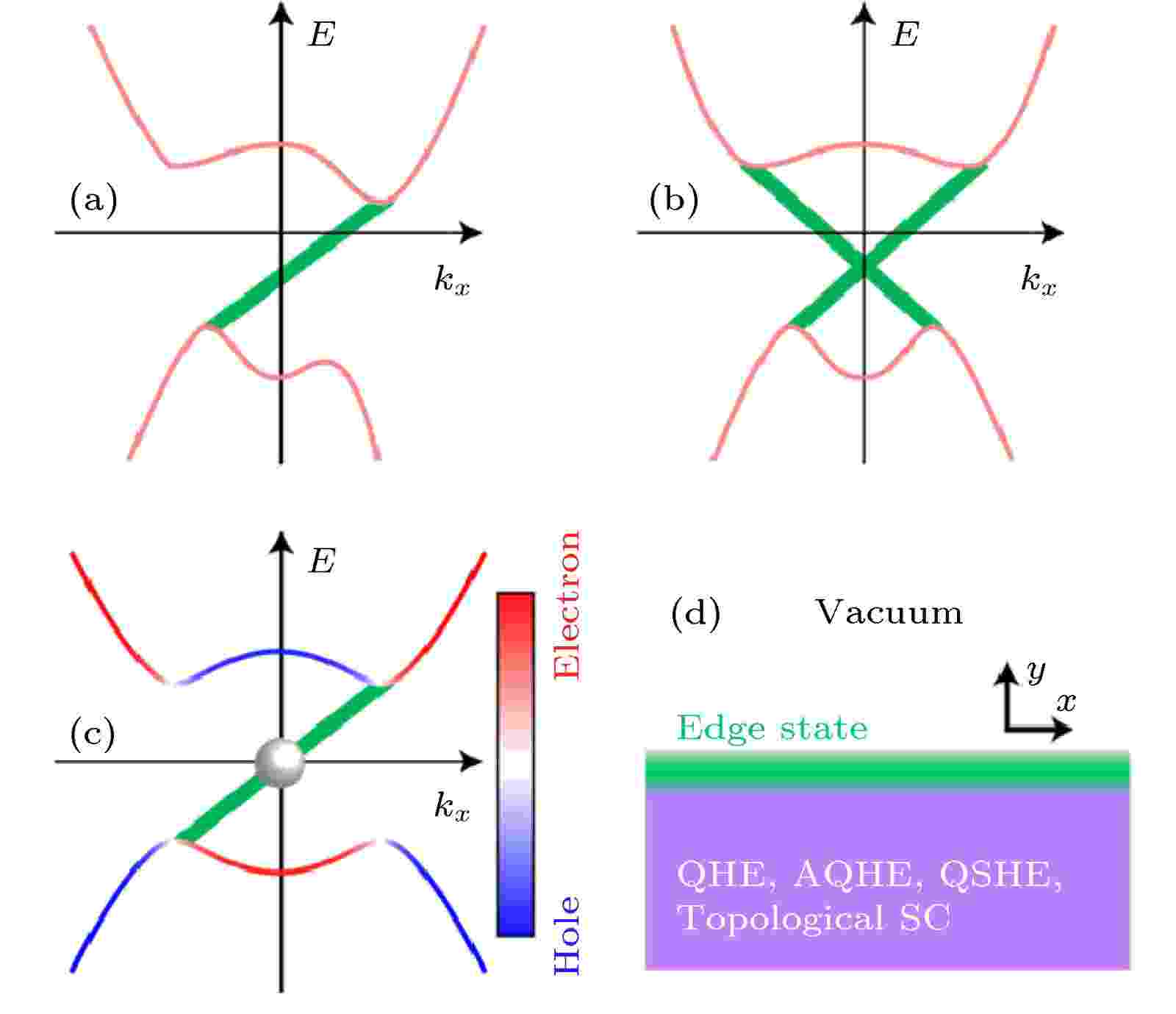 图 1 (a) 量子霍尔效应及量子反常霍尔效应; (b)量子自旋霍尔效应; (c) 拓扑超导的体能带结构(红线和蓝线)和边缘态(绿色)的色散关系; (d)实空间边缘态的示意图
图 1 (a) 量子霍尔效应及量子反常霍尔效应; (b)量子自旋霍尔效应; (c) 拓扑超导的体能带结构(红线和蓝线)和边缘态(绿色)的色散关系; (d)实空间边缘态的示意图Figure1. Schematic energy band structures for (a) quantum Hall effect and quantum anomalous Hall effect, (b) quantum spin Hall effect, (c) a topological superconductor and (d) sche-matic diagram of topological edge/surface states in real space.
和绝缘体一样, 具有能隙的超导态也可以划分为具有非平庸拓扑特征的超导态和平庸的超导态. 因为超导具有粒子空穴对称, 拓扑超导的最显著的特征是其零能的准粒子激发[5-10]. 这些被称为零能Majorana束缚态的准粒子, 有利于稳定的拓扑量子计算的实现. 本文介绍拓扑超导的机理、Majorana束缚态的新奇物理特性、实验观测和操作的方法、量子器件的设计,并展望该研究方向的发展前景.













显然有









 图 2 拓扑超导约化能隙
图 2 拓扑超导约化能隙
Figure2. Distribution of normalized topological superconduc-tivity gap

利用电子的产生算子





两个Majorana束缚态可以表达一个电子态,
在普通的s波超导体里, 两个反向自旋的电子形成一个库珀对. 在这种情况下, 由于电子和空穴的自旋彼此相反, 由此定义出来的准粒子



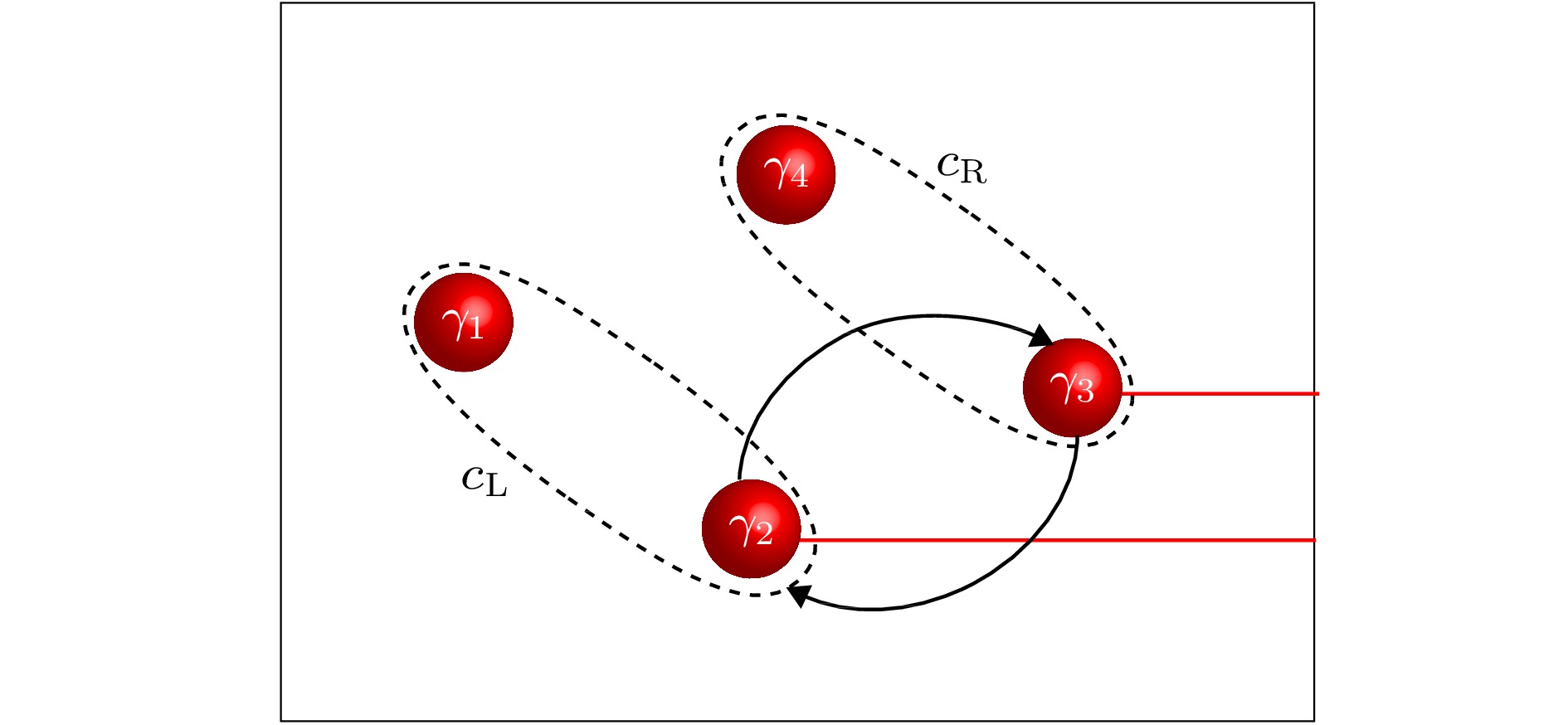 图 3 利用拓扑超导量子涡旋里的Majorana束缚态实现非阿贝尔统计的示意图, 其中黑色箭号代表量子涡旋位置交换的轨迹, 当量子涡旋跨越红线时超导相位发生2π的不连续跳跃
图 3 利用拓扑超导量子涡旋里的Majorana束缚态实现非阿贝尔统计的示意图, 其中黑色箭号代表量子涡旋位置交换的轨迹, 当量子涡旋跨越红线时超导相位发生2π的不连续跳跃Figure3. Schematics of realization of non-Abelian statistics using Majorana bound states in vortex cores of a topological superconductor. Black arrows denote the exchanging paths of two quantum vortices. Superconducting phase takes a 2π jump when a vortex crosses the red cuts.




进一步可以考虑将(5)式用电子态湮灭算子(4)式以及对应的产生算子来表达. 如图3所示, 4个Majorana束缚态









2
5.1.一 维量子线
对于二维拓扑超导体来说, 在体材料的边界处, 束缚态变成了连续的边界态. 如图1(c)所示, 这些边界态满足连续的色散关系, 因此难以实现受有限能隙保护的零能量Majorana束缚态. 另一方面, 一维的拓扑超导体, 其边界态是具有局域波函数的束缚态, 而体系具有有限能隙, 因此有利于产生具有拓扑保护的零能Majorana束缚态[15].为了在实际体系中实现一维拓扑超导态, Lutchyn等[19]提出了一种如图4(a)所示的超导体-半导体混合系统. 在这个系统里, 半导体纳米线具有很强的自旋轨道耦合, 这样原本具有两重自旋简并的能带结构就在动量方向上发生劈裂(如图4(b)所示), 具有向外自旋的电子能带向左平移, 而具有向内自旋的电子能带则向右平移. 此时, 费米能附近主要有两类电子态: Γ点附近的线性Dirac电子, 以及两边kF费米动量附近的电子态. 如果在纳米线上施加足够大的外部磁场, 塞曼劈裂就会打破时间反演对称性带来的Kramers简并性, 使得Γ点附近的线性Dirac电子消失(图4(b)). 此时在该系统中, kF动量附近的电子具有动量-自旋锁定, 即相反动量的电子携带几乎相反的自旋. 这样, 由s波超导态带来的Cooper对可以通过近临效应在纳米线中引致超导. 同时, 由于纳米线是一维系统, 电子不会具有回旋运动, 这抑制了磁场对超导的破坏. 动量-自旋锁定的能带结构加上s波超导, 使得超导能隙仅在费米能附近的单个能带中打开, 这样就在纳米线中实现了等效的无自旋超导性. 由于泡利不相容, 无自旋超导体的超导能隙必定具有p波或者f波的空间对称性. 理论计算表明图3中的系统对应于p波超导体[17], 因此, 尽管此系统的超导Cooper对来源于正常的自旋单态s波超导体, 但通过近邻效应在自旋轨道耦合的半导体中的实现了等效的无自旋p波超导性 .
 图 4 (a)具有自旋轨道耦合的半导体纳米线和s波超导的混合系统的示意图; (b)半导体纳米线在有限磁场(实线)和零磁场(虚线)下的色散关系
图 4 (a)具有自旋轨道耦合的半导体纳米线和s波超导的混合系统的示意图; (b)半导体纳米线在有限磁场(实线)和零磁场(虚线)下的色散关系Figure4. (a) Schematics of a heterostructure consisting of a spin-orbital coupling semiconductor nanowire and an s wave superconductor; (b) the band dispersion of the nanowire with finite magnetic field (solid lines) and zero magnetic field (dashed lines).
在最近的实验中, 哥本哈根大学的研究组实现了图4(a)所示的超导体-半导体杂化系统. 他们将超导的金属铝生长在半导体InAs纳米线的表面, 并施加合适的外部磁场, 然后进行库仑阻塞的实验测量[24]. 在传统的界观超导体中, Cooper对的两个电子必须同时隧穿, 带来分立的电导峰, 这是常见的库仑阻塞的信号. 然而在这个新的半导体-超导杂化系统中, 实验上发现了由单电子隧穿所带来的库仑阻塞的信号. 这意味着除了常规的超导基态(电子占有数的偶数状态)之外, 还存在一种电子占有数为奇数的基态. 由于超导体中电子都是以Cooper对的形式出现, 此实验就提供了一个有力的证据, 表明Majorana约束缚态状态存在于细线的两端并且带来了简并的超导基态.
2
5.2.由Majorana束缚态所带来的新奇量子隧道现象
当一维拓扑超导体的末端存在如图4(a)所示的Majorana束缚态时, 在系统中会出现新的量子隧穿现象. 其中尤其有趣的一种是约瑟夫隧道效应. 我们考虑如图5(a)所示的拓扑约瑟夫森结, 两边都是一维拓扑超导体. 此时, 约瑟夫森结中的Majorana束缚态组成一个量子比特系统, 如图5(b)所示, 其有效哈密顿量为 图 5 (a) 通过电压差控制Majorana量子比特的设计; (b) Majorana量子比特的两能级系统; (c)-(e) 量子比特在电流脉冲下的LZS震荡: (c)短脉冲, (d)长脉冲, (e)序列脉冲[25]
图 5 (a) 通过电压差控制Majorana量子比特的设计; (b) Majorana量子比特的两能级系统; (c)-(e) 量子比特在电流脉冲下的LZS震荡: (c)短脉冲, (d)长脉冲, (e)序列脉冲[25]Figure5. (a) Schematic design of a universal quantum gate for Majorana qubit, where the qubit is manipulated by voltage across the Josephson-Majorana junction; (b) the two energy levels of the Majorana qubit depending on the phase difference across the junction; (c)-(e) the LZS oscillation of Majorana qubit under current pulse: (c) a short pulse, (d) a long pulse, (e) a sequence of pulses[25].











如上所述, 虽然Majorana束缚态在空间上是分离的, 但实际上一对Majorana束缚态共同描述了拓扑超导体的量子态(即电子占有数的奇偶性), 因此Majorana束缚态处于量子纠缠状态. 这个物理特性可以用来实现基于Majorana束缚态的量子传送(teleportation)[27]. 如图6(a)所示, 可以在两端带有Majorana束缚态的一维拓扑超导体的两端各自放置一个量子点, 调制一维拓扑超导体与量子点之间的量子隧穿. 由于两个远距离的Majorana束缚态之间具有长程纠缠, 而每个Majorana束缚态又分别与量子点进行局域耦合, 最后导致两个量子点的占据态之间也产生了非局域的纠缠. 如图6(b)所示, 考虑了两个量子点的电子占有率的关联函数[28]. 考虑一维拓扑超导体的库仑阻塞效应, 可以发现空间上分离的两个量子点的电子占有率之间具有非局域的量子关联, 而这种量子关联也正体现了Majorana束缚态之间的纠缠性.
 图 6 (a) Majorana束缚态与量子点耦合体系; (b)两个量子点的占据态关联函数[28]
图 6 (a) Majorana束缚态与量子点耦合体系; (b)两个量子点的占据态关联函数[28]Figure6. (a) System with couplings between Majorana bound states and two quantum dots; (b) correlation between the electron occupations on the two quantum dots[28].
2
5.3.二维拓扑超导的量子涡旋和Majorana束缚态
5.2节讨论了一维拓扑超导纳米线两端的边界Majorana束缚态的物理性质, 本节讨论二维拓扑超导体的量子涡旋中的Majorana束缚态及其量子性质. 与图4(a)中具有强自旋轨道耦合的量子线相似, 三维拓扑绝缘体的表面出现自旋和动量锁定的二维Dirac表面态(如图7(a)所示). 因此该二维电子系统也可以通过类似机制实现二维无自旋的手征p波超导[16]. 由于拓扑绝缘体的上下表面在理想情况下各自仅具有一个Dirac电子态费米面, 因此实现无自旋超导无需借助Zeeman场. 根据上述理论, 上海交通大学实验组在NbSe2超导衬底上生长了三维拓扑绝缘体Bi2Te3薄膜. 通过调节拓扑绝缘体薄膜的厚度调制费米面位置使其位于拓扑绝缘体的导带和价带之间, 并利用扫描隧道显微镜/扫描隧道谱(STM/STS)观察了超导量子涡旋里的准粒子激发, 捕捉到了Majorana束缚态的信号(图7(b))[22].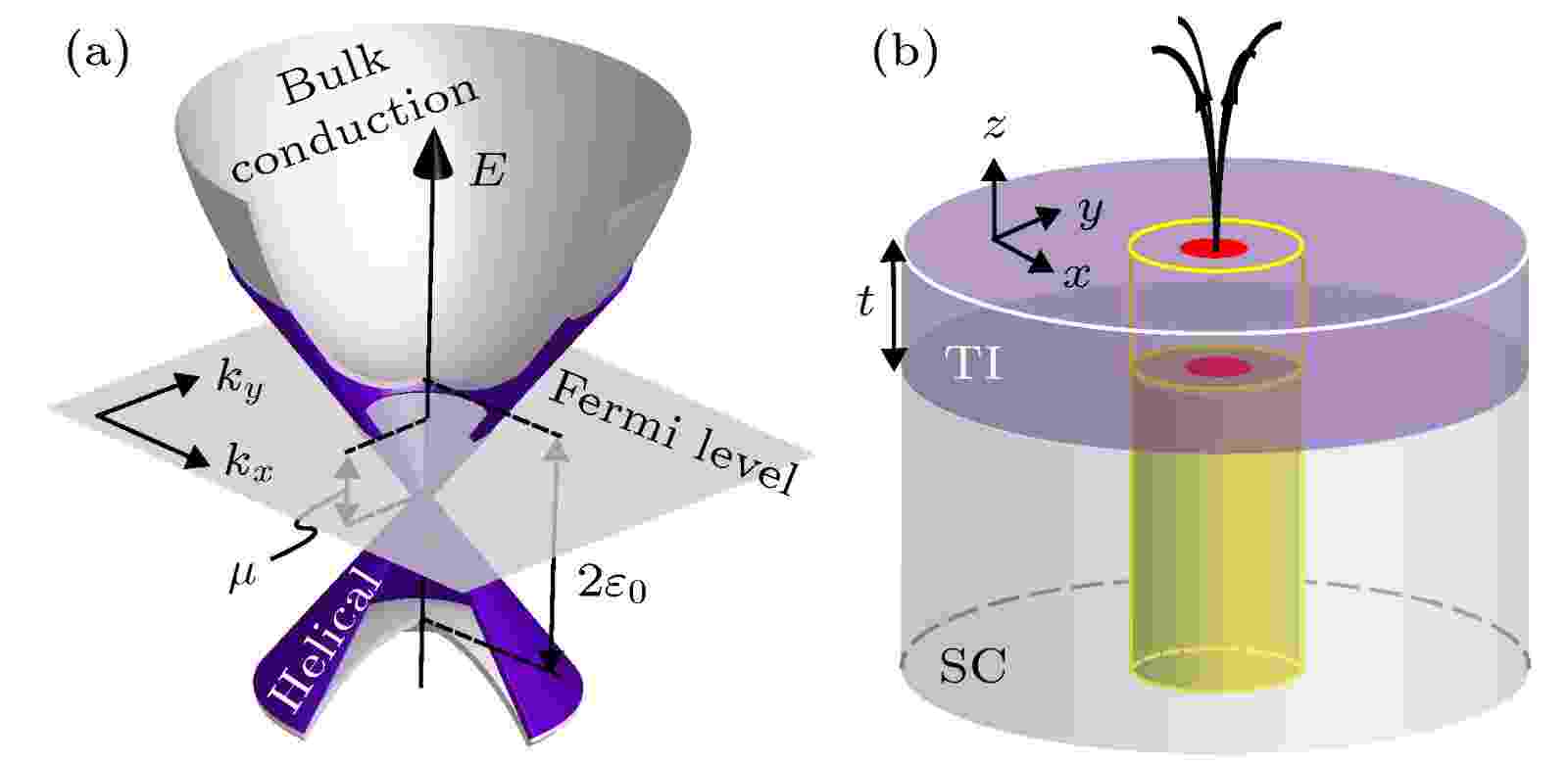 图 7 三维拓扑绝缘体(TI)色散关系(a)及TI-s波超导(SC)的异质结(b)的示意图, (b)中的红点代表Majorana束缚态[29]
图 7 三维拓扑绝缘体(TI)色散关系(a)及TI-s波超导(SC)的异质结(b)的示意图, (b)中的红点代表Majorana束缚态[29]Figure7. (a) Schematic of the linear dispersion of surface state of a 3D TI; (b) schematic of a TI/s-SC heterostructure, where the red points denote the Majorana bound states at the center of a quantum vortex[29].
我们再从理论上分析超导量子涡旋里的Majorana束缚态的能量和角动量. 为方便起见, 考虑单个量子涡旋. 此时, 超导准粒子激发的总角动量是一个好的量子数, 共有三项贡献:



Majorana束缚态的总角动量归零可以由两组不同的自旋角动量和轨道角动量的组合来实现,




 图 8 (a)拓扑超导量子涡旋里的低能准粒子激发的自旋分辨波函数; (b)准粒子激发的自旋向上态密度和自旋向下态密度之比的能量-空间分布[29]
图 8 (a)拓扑超导量子涡旋里的低能准粒子激发的自旋分辨波函数; (b)准粒子激发的自旋向上态密度和自旋向下态密度之比的能量-空间分布[29]Figure8. (a) Spin-resolved wavefunctions of the low energy quasiparticle states in the vortex core of a topological superconductor; (b) spectrum of the ratio between densities of states for the spin-up and spin-down components[29].
但是, 如果区分自旋分量, 比如关注自旋向上的准粒子激发态密度, 很明显Majorana束缚态和第一激发态的波函数振荡的峰和谷正好相反. 类似的反向振荡也出现在自旋向下的准粒子激发态密度, 以及具有负能量的第一激发态中. 这个特征可以用来区分Majorana束缚态和其他的激发状态.
为了更清晰地显示Majorana束缚态和其他的激发状态的不同, 我们计算了不同能量的准粒子激发态里自旋向上和自旋向下的态密度分量的比率. 如图8(b)所示, 作为能量和实空间位置的函数, 自旋分辨态密度呈现明显的棋盘式图案. Majorana束缚态对应于棋盘中能量为零的一列, 明显区别于相邻列所对应的第一激发态. 因此, 分析显示使用自旋极化STM/STS方法可以从超导量子涡旋里准粒子激发谱利将Majorana束缚态作为单量子态分离出来. 最近实验上已经开始尝试自旋分辨STM/STS方法[31], 期待在不久的将来通过棋盘式图案的测试, 提供Majorana束缚态的精准证据.
2
5.4.实现非阿贝尔统计的纳米超导器件
上面已经解释了与量子涡旋交换相关的非交换统计量, 但在技术上精确地控制和移动量子涡旋非常困难. 本节将介绍通过栅极电压操纵Majorana束缚态的理论方案[32]. 首先, 将如图9(a)中所示拓扑超导块作为方案的一个基本单元. 该单元的拓扑超导态可利用第4节所介绍的异质结机制在半导体薄膜上实现[18]. 当一个量子涡旋进入单元中心时, Majorana束缚态将出现在量子涡核心中. 由于Majorana束缚态始终成对出现, 另一伴随的Majorana束缚态将出现在块体的边缘(图9(b)).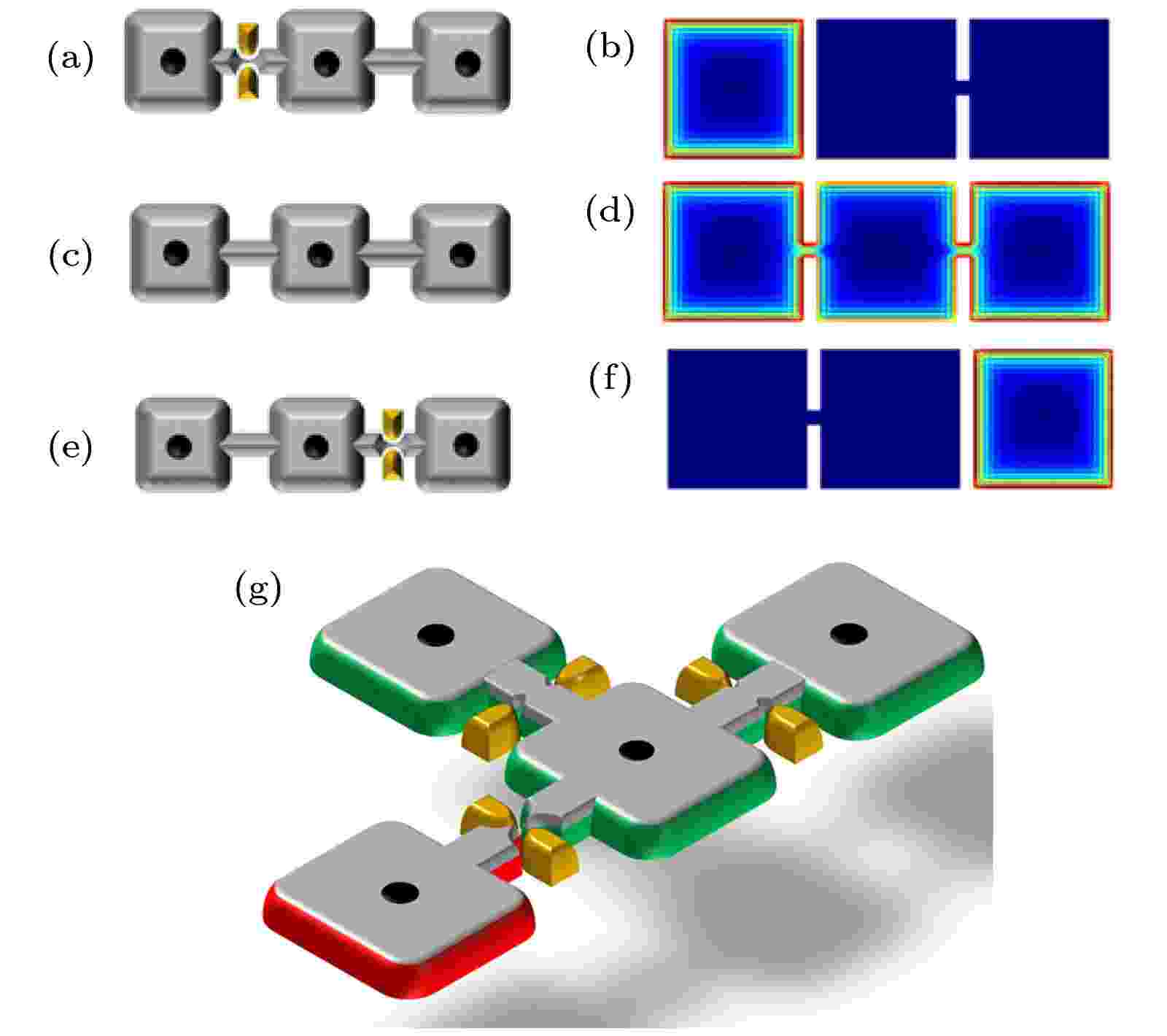 图 9 (a), (c), (e), (g)为利用栅极电压移动边界Majorana束缚态的示意图; (b), (d), (f)给出了与(a), (c), (e) 相对应的Majorana束缚态的波函数分布[32]
图 9 (a), (c), (e), (g)为利用栅极电压移动边界Majorana束缚态的示意图; (b), (d), (f)给出了与(a), (c), (e) 相对应的Majorana束缚态的波函数分布[32]Figure9. (a), (c), (e), (g) Schematic of the device which transports edge Majorana states using gate voltages; (b), (d), (f) corresponding wavefunctions of the edge Majorana states in (a), (c), (e)[32].
接下来考虑三个块体的组合. 块体通过结连接起来, 结的开(on)和关(off)通过结上的栅极来控制. 在起始状态, 通过向左侧结施加栅极电压来隔离左块. 此时, 边缘的Majorana束缚态仅出现在左侧块中(图9(a),(b)). 而对于右边的处于连接状态的两个块体, 其涡流核心各有一个Majorana束缚态组成一对伴随的Majorana束缚态, 而边缘则没有Majorana束缚态. 在这里两个块体边缘的Majorana态的消失可以理解为(9)式中第三项因为两个磁通的贡献变成-1, 总角动量归零

一个完整的编织操作(braiding)涉及两个Majorana束缚态, 需要4个超导块体来实现该操作. 考虑由如图9(g)中所示的4个块体单元组合成的器件. 在初始状态, 隔离左右块并连接中间的两个块体, 此时Majorana束缚态出现在左右块的边缘上. 参考图9(a)—(f)中的过程, 首先将左块Majorana束缚态运送到最上方的块体. 然后, 将右Majorana束缚态传送到左侧块. 之后再将已经转移到最上方块的Majorana束缚态运送到右块. 经过此过程, 器件的设置恢复至初态, 而左右块中的边界Majorana束缚态则发生了交换. 含时BdG方程的数值分析也证明经过交换后右侧Majorana束缚态获得了额外π的相位[32,33]. 以这种方式, 便实现了公式(5)中非交换统计所需的Majorana束缚态的编织操作.
2
5.5.基于Majorana量子比特的单电子泵
研究拓扑超导中的Majorana束缚态的最初动机是由于其在拓扑量子计算中的巨大应用潜力. 本节介绍利用边缘Majorana束缚态来实现Majorana量子比特的NOT操作[34]. 图10(a)和图10(b)给出了该量子器件的示意图. 图10(b)的右侧4个超导块体单元形成一个环, 环的中心固定有一个量子涡旋. 环左侧则为一个独立超导单元. 左侧超导块的边界和中心涡旋处各有一Majorana束缚态, 两者恰好构成一个量子比特. 初始状态时, 右侧4个超导块保持在图10(a)中左下角所示的状态. 随后利用5.4节介绍的Majorana束缚态转移方式, 可以驱动左边孤立块体上的边缘Majorana束缚态环绕右边4个块体组成的圆环一周, 并最终达到图10(a)中右上角所示的终态. 环绕中心涡旋一周后Majorana束缚态将获得一个π相位(图10(a)), 这相当于对左侧块体上的Majorana量子比特实施了一个NOT变换, 使其上电子数的奇偶性(parity)发生反转. 需要注意的是, 在终态时右边4个超导块体间的水平结处于导通状态而垂直结处于断开状态, 这一设置刚好与初态相反. 可以严格证明结的连接状态的转换将导致右侧超导环上的基态电子数奇偶性反转[34], 而整个系统的粒子数奇偶性仍保持不变.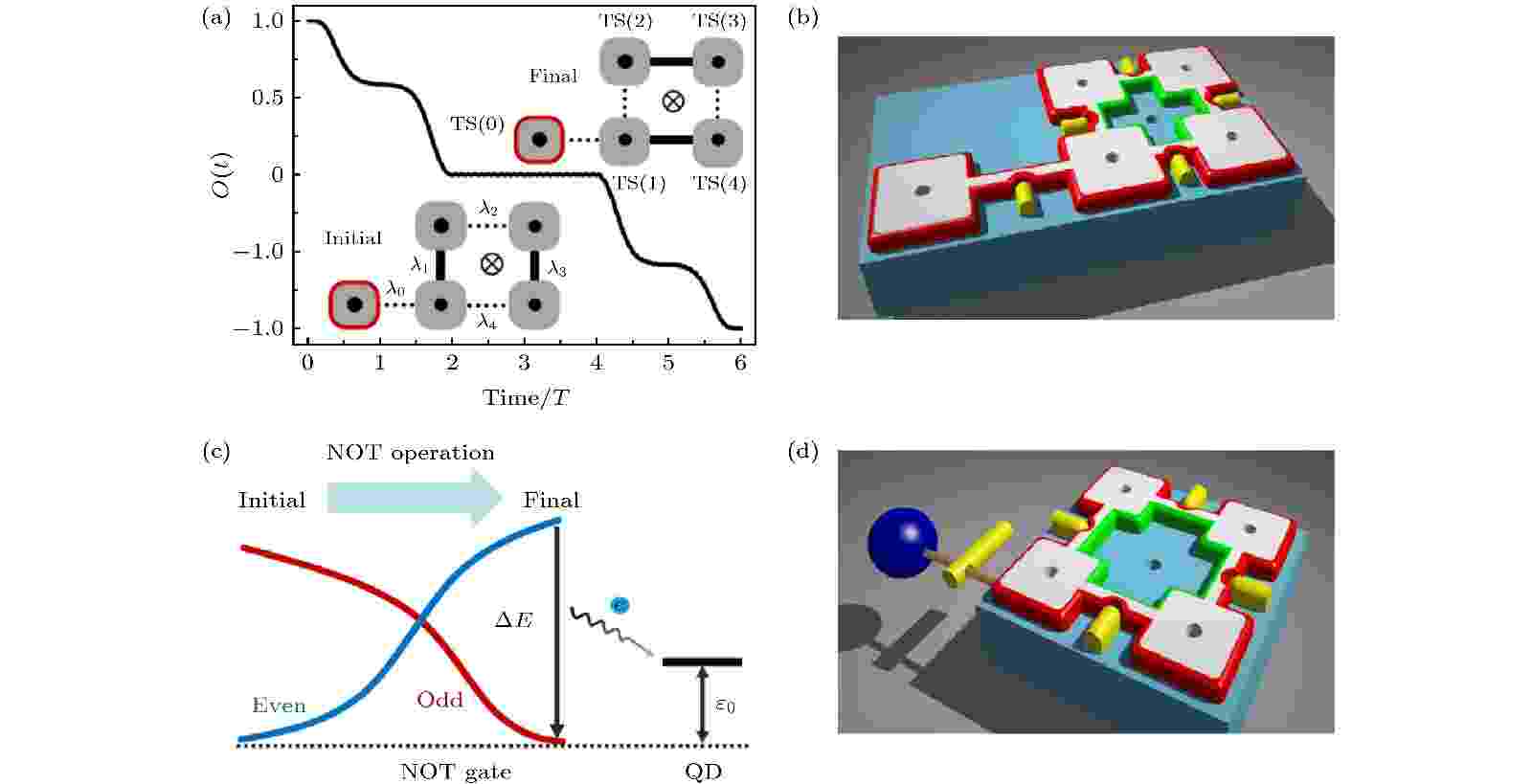 图 10 (a), (b) Majorana量子比特的NOT量子门操作; (c), (d) 基于边界Mojorana束缚态的单电子泵[34]
图 10 (a), (b) Majorana量子比特的NOT量子门操作; (c), (d) 基于边界Mojorana束缚态的单电子泵[34]Figure10. (a), (b) NOT quantum gate operation of the Majorana qubit; (c), (d) a single-electron pumping based on the edge Majorana states[34].
若把图10(b)的左侧Majorana量子比特替换为常规量子点(图10(d)), 就可能实现单电子泵. 设初始时量子点处于空态, 而4个超导块之间的结处于与图10(a)中的初态. 通过对垂直结施加栅极电压而把水平结的栅压减小, 即对右侧超导块体环实行NOT操作, 超导块环的基态电子数奇偶性将发生如图10(c)所示的转变. 由于超导体环和量子点组成的体系整体电子数奇偶性守恒, 超导体因此将向量子点“排挤”出一个电子. 此时若将量子点与一个外电路连接, 就能向外逐个地输出电子, 从而实现单电子泵的功能.
基于量子叠加态的量子计算有着广泛而重要的应用前景, 例如可以用于开发最先进的加密技术, 实现大规模量子模拟以揭示新奇物理现象和开发新型量子物质. 目前以IBM、微软和谷歌为代表的企业也开始着手量子计算机的开发, 可以说一场全球范围内的开发竞争正在如火如荼地展开. 但是, 量子系统的退相干问题依然是量子计算机开发的瓶颈, 亟待解决. 从原理上看, 使用Majorana束缚态建立拓扑量子位具有很大的优势, 期待其研究开发在不久的将来发生颠覆性进展.
尽管基于Majorana束缚态的拓扑量子计算可能提供常规量子计算方案所不具备的超强抗干扰能力, 但是它并不能够单独完成所有的量子计算操作. 因此, 研究Majorana量子比特与常规量子比特之间的耦合效应并最终实现全局量子计算, 也将会是一个重要的研究方向.
